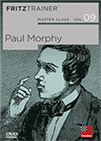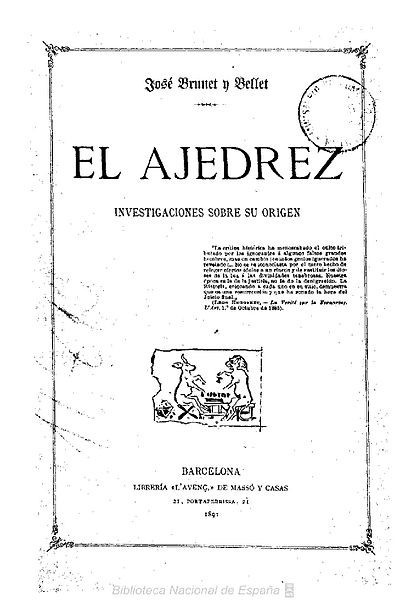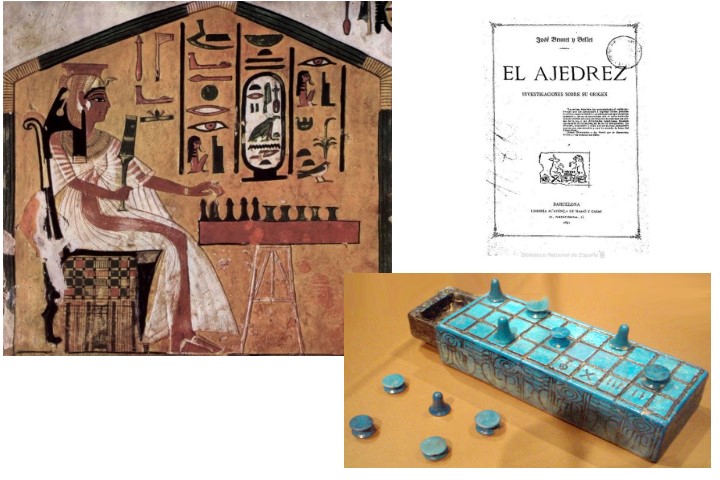See Part 1: Introduction | Part 2: Indian origin | Part 3: Chinese origin
Part 4: Egyptian origin of chess
An inconsistent hypothesis
A probable Egyptian origin of chess is based on classical accounts corresponding to ancient Greece, which had a lot of influence in the Middle Ages, and even later. A myth is held in which the game was created by Tot, the god of wisdom, a deity who had authority over the other gods of the pantheon in Egypt.
The Greeks would have inherited the game from this ancient civilization, although it should be clarified that the most popular board game among them was petteia, which can hardly be considered a variant of proto-chess. Although it could be placed, along with other games, as a possible contribution to the creation of a different practice that could be considered a relatively direct antecedent of chess.
Plato, in Phaedrus, a work written in 370 B.C., one of his well-known invocations to Socrates, assures in fact that chess (petteia) came from the neighboiring culture, placing its entrance in the 5th to 4th centuries B.C. The passage in question reads specifically: “At the Egyptian city of Naucratis, there was a famous old god, whose name was Theuth; the bird which is called the Ibis is sacred to him, and he was the inventor of many arts, such as arithmetic and calculation and geometry and astronomy and draughts [1] and dice, but his great discovery was the use of letters”.
The greatest efforts in modern times in favour of the thesis of an Egyptian origin of chess were made in the 19th century by Spanish (from Catalonia) researcher Josep Brunet i Bellet.[2]
 Learn about one of the greatest geniuses in the history of chess! Paul Morphy's career (1837-1884) lasted only a few years and yet he managed to defeat the best chess players of his time.
Learn about one of the greatest geniuses in the history of chess! Paul Morphy's career (1837-1884) lasted only a few years and yet he managed to defeat the best chess players of his time.
Original edition of the work by Brunet i Bellet | Image: Wikimedia Commons
While noting certain weaknesses in the Indian-origin theory (he proposed to somehow break away from the prevailing paradigm), it sought to construct an explanatory alternative, focusing on Egyptian culture. In this context, he came to assume that not only did the game have this origin, but that the means of dissemination were different from those conventionally accepted. According to the Catalan author, the game travelled from Egypt to Greece and Rome, and only later to India and Persia (in the times of Alexander the Great).
He based his theory on this explanatory route, in addition to other literary references — such as the one previously mentioned by Plato —, in some pictorial images and the discovery of statuettes in excavations carried out in the domains of the Egyptian culture. These ancient references were improperly ascribed to some variant of proto-chess.
After all, it was possible to elucidate that the construction of this theory was somewhat forced, since at least a confusion of games was verified. When the ancient Greek philosophers spoke of a board game, they referred to petteia, a game that is far from being considered a variant of chess. The same could be said of the Roman ludus latrunculorum, to which the famous poet Ovid referred to much earlier.[3]
Similarly, the images found in murals and archaeological pieces correspond to senet (zn.t n.t ḥˁb in ancient Egyptian), a very ancient game of that culture, one of the first created by humanity. Because of its characteristics (morphology, system of rules and conception), it cannot in any way be directly linked to chess. An association between them could only be established within the framework of an evolutionary chain of many links in which senet would occupy an initial space while chess would appear much later.
Brunet i Bellet based his thoery on some iconic images that correspond to senet, probably the oldest that are available as evidence of ancestral pastimes. In this sense, when the Catalan created his theory, it was known that in the tomb of Thebes there existed an image that corresponds to Pharaoh Ramses III (he ruled in the 12th century BC) and another, from even earlier times, corresponding to the tomb of Queen Nefertari (she lived in the 14th century BC). There was also a mortuary cloth, sewn in gazelle skin, which belonged to Queen Isi-em-Kheb (in Solomon's time, i.e. around 1000 BC), which includes a board game with various pieces, in the shape of a gazelle, a goose and a beetle.
The image of Nefertari is convincing in that she is playing a game with statuettes, one of the first expressions of this type (previously simpler, circle-shaped pieces were known), which correspond to senet. This game had an eschatological connotation, since it was practiced, as is evident in this case, during the transit from the earthly world to that of transcendence. That departure, then, links its protagonist to the final destiny. In the same way, it is known that another pharaoh, Tutankhamun (14th century BC), had four games of senet in his pyramid (mausoleum) to play for eternity, and that a century later an artisan (a sign that the game was not restricted only to the ruling class), named Sennedyem, appears in inscriptions on his tomb playing it with his wife.
In any case, senet was associated with divination practices, since it represents the Judgment of Osiris (the Egyptian god of death), the victory of the deceased and their entry into the Duat, the underworld in which the souls of the dead were to wander, avoiding spells and being tested — playing senet was one of them. The game is mentioned in the Book of the Dead, an old funerary text that dates back to the 16th century BC. In chapter XVII, a deceased person is presented practicing a board game (in some translations it is incorrectly said that he is playing checkers), while he believes he is still a living soul in the presence of Osiris.

A painting in the tomb of the Egyptian Queen Nefertari | Image: Wikimedia Commons
By the way, senet means "passage" or "transit", a clear sign of a path from earthly space to the definitive one. However, according to some studies, this game would not be the first one to have these connotations, but it could have a close relationship with a previous one, mehen ("the God of board games"), an Egyptian game from which senet would have received in inheritance the metaphysical message linked to the eternal world.[4]
After Brunet i Bellet's work, there were other discoveries, quite old, but corresponding to a game that cannot be considered a variant of proto-chess. For example, on one of the walls of the tomb of Hesy, pharaoh of the Third Dynasty (c. 2650 BC), there is a painting showing pieces in the form of statuettes. And it would also seem that some hieroglyphs from the tomb of Merknera (years 3,300 to 2,700 BC) would be connected to senet. Fragments of tables corresponding to the First Dynasty (c. 3100 BC) have also been found.
It has to be said once and for all. While senet could, in some perspective, be considered a precursor to all subsequent board games — including chess[5] — it would be forced to establish a close link between them: the differences are far more important than the similarities. Although both games are for two players, senet is played on a board of 30 squares arranged in three rows (very different from the classic 64 squares that characterizes all known proto-chess variants); the number of pieces, although not absolutely clear, could be between 10 and 20 (and not 16); the mobility of the pieces, at least in the early versions, is similar between them (and not differentiated as in chess); and the main objective is limited to removing one's own pieces from the board before the opponent does (instead of trapping or checking the main opposing piece). It is then a race game and not one of strategy, as obviously chess always has been, even in its ancestral versions.[6]
It must be recognized that senet had some essential characteristics that were later seen repeatedly in the known variants of proto-chess: it was played on a chequered board; pieces were used in the form of statuettes; its practice had a cosmogonic implication.[7] However, it is necessary to discard its direct relationship with chess, both because of the lack of an intrinsic correlation, and because of the geographical and temporal disconnection with any eventual sequence of diffusion of the game, if we consider the moment of the entry of proto-chess in Baghdad. It is also inconsistent with the times when the first traces of any theory about the origin of chess could have been verified, of which there is clear documentary evidence.

A ‘senet’ board that may correspond to the 14th century B.C.
 He was a child prodigy and he is surrounded by legends. In his best times he was considered to be unbeatable and by many he was reckoned to be the greatest chess talent of all time: Jose Raul Capablanca, born 1888 in Havana.
He was a child prodigy and he is surrounded by legends. In his best times he was considered to be unbeatable and by many he was reckoned to be the greatest chess talent of all time: Jose Raul Capablanca, born 1888 in Havana. The Egyptian civilization was more closely related to ancient Greece and Rome, than to Persia and India. The chronological jump that takes place between the moment in which the images of senet were produced and the moment in which records of variants of proto-chess were discovered in India and Persia — or in the Arab world and eventually the distant China — is gigantic. Under these conditions, no sequence of dissemination that would have Egypt as its starting point is plausible.
Therefore, in addition to its interconnection with the Babylonian game of which it could be relatively contemporary (it is even speculated that they could have appeared independently), senet could have influenced the appearance of the Greek petteia and the Roman ludus latrunculorum. Recognizing this, the debate on the link between chess and senet could be reopened for one simple and exclusive reason: there are theories that maintain that the Greek board game was an input for a variant of proto-chess that emerged later in the course of the Silk Road. In this context, not directly, as Brunet i Bellet wrongly argued, but indirectly, one could contemplate the possibility of an influence of the very old senet on the subsequent board games that led to the creation of chess.
Given this evidence, the efforts of Brunet i Bellet, being valuable in their interpellation to the prevailing theory (that of the Indian origin), are far from having served to cement an alternative paradigm. In fact, no subsequent investigator followed the trail which, at some point, for a short time, showed some strength. A theory that ended up being insufficient and incorrect in its explanatory capability.
See Part 1: Introduction | Part 2: Indian origin | Part 3: Chinese origin
Notes and references
[3] When Ovid (43 BC-17 AD) mentions the activities that beautiful women could do, of course he refers to the ludus latronculorum and not to chess, despite very free translations such as the following: “I should wish her to play chess with skill and caution. One piece against two is bound to go under. A king that is battling, separated from his queen is liable to be taken; and his rival is often compelled to retrace his steps. Again, when the ball bounces against the broad racquet, you must only touch the one you intend to serve. There is another game divided into as many parts as there are months in the year. A table has three pieces on either side; the winner must get all the pieces in a straight line. It is a bad thing for a woman not to know how to play, for love often comes into being during play”. Source: The art of love (Ars Amatoria), Ovid, Book III, Part VIII: Learn, Dancing, Games, translated by A. S. Kline, at http://www.sacred-texts.com/cla/ovid/lboo/lboo60.htm. Ovid mentions in Latin latronum proelia lude that is to say "the game of the battle of the thieves" or our ludus latrunculorum. The key phrase of the passage continues to be "Ludere: ludendo saepe paratur amor", that is: "Play: playing always brings love", at http://www.thelatinlibrary.com/ovid/ovid.artis3.shtml.
[5] It is possible to trace a hypothetical line of inter-generational and inter-spatial transmission of games that begins in senet and continues with the Real (Sacred) Game of Ur, a Babylonian pastime that is from the middle of the second millennium BC. In it, each player has seven pieces, seven Sumerian gods and the floors of the temple tower dedicated to the sovereign Marduk (which is supposed to be that of Babel). The Sacred Game of Ur has been considered (Schädler) the predecessor of four-player chess with the use of dice. Source: On the Rules for the Royal Game of Ur, Irving Finkel, at https://www.academia.edu/15173145/On_the_Rules_for_the_Royal_Game_of_Ur.
[6] At this point we can follow the taxonomy presented by another Catalan, the contemporary scholar Gaspar Pujol Nicolau, for whom senet is a path-based game (the pieces move in a one-dimensional direction), in any case more related to ludo or to backgammon, and not space-based games (strategical) to which all possible chess variants must be ascribed.
[7] Some archaeologists claim that the Egyptians believed that they should face some deity in senet in their transit towards the promised land — the result of the game decided the final destiny of each person.


























